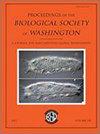日本副瘟藻的颜色模式变异、命名鉴定和重新描述(Temminck&Schlegel,1846)(Teleostei:胸形目:舌藻科)
IF 0.5
4区 生物学
Q3 Agricultural and Biological Sciences
引用次数: 0
摘要
摘要主要在中国东部至南部沿海的鱼类登陆港采集到具有三条眼侧侧线和不同眼侧颜色图案的边缘唇舌底。样本被分为三组:具有先前报道的日本副瘟疫(Temminck&Schlegel,1846)的颜色模式的样本,称为颜色模式I(CPI)和颜色模式II(CPII);以及初步鉴定为具有不同颜色模式(CPIII)的Parapestisia sp。CPI的特点是只有浅ocelli叠加在绿棕色或黄棕色的背景色上;CPII的特点是只有黑色斑点叠加在棕黑色或灰棕色的背景色上;CPIII的特征是淡ocelli和黑点混合在黄褐色或棕黑色的背景色上。与CPII(191.7–337.1 mm SL)和CPIII(155.9–352.9 mm SL)样本的长度相比,具有CPI图案的样本的体型较小(78.3–279.0 mm SL)。为了确定具有CPIII的标本是否代表不同于日本血吸虫的物种,分析了一系列形态特征和两个部分基因序列(COI和RAG1)。分析表明,具有这三种不同颜色模式的标本在27个形态特征上重叠,包括9个分生组织特征和18个形态计量特征。COI和RAG1片段的K2P遗传距离分别为0.000-0.007和0.000-0.006。本研究证实,生活在中国沿海水域的边缘唇舌底具有三条侧线,但具有不同的眼侧色素沉着模式,属于一个物种,即P.japonica。这些结果还提醒使用色素特征作为诊断特征来区分副瘟疫种。提供了最新的日本P.japonica的重新描述和同义词,包括形态特征和色素沉着的变化、成熟时的大小和地理分布的摘要。本研究的结果将有助于更好地理解舌骨比目鱼颜色模式的分类学意义。本文章由计算机程序翻译,如有差异,请以英文原文为准。
Color pattern variation, nomenclatural appraisal, and re-description of Paraplagusia japonica (Temminck & Schlegel, 1846) (Teleostei: Pleuronectiformes: Cynoglossidae)
Abstract. Fringe-lip tongue soles with three ocular-side lateral lines and different ocular-side color patterns were collected mainly at fish landing ports from east to south coastal regions of China. Specimens were divided into three groups: those with color patterns previously reported for Paraplagusia japonica (Temminck & Schlegel, 1846) called Color Pattern I (CPI) and Color Pattern II (CPII); and those, preliminarily identified as Paraplagusia sp., that featured a different color pattern (CPIII). CPI featured only pale ocelli superimposed on a greenish-brown or yellowish-brown background color; CPII featured only black spots superimposed on a brownish-black or grayish-brown background color; and CPIII featured both pale ocelli and black spots mixed over a yellowish-brown or brownish-black background color. Specimens with CPI pattern are smaller in body size (78.3–279.0 mm SL) compared to the lengths of specimens with the CPII (191.7–337.1 mm SL) and CPIII patterns (155.9–352.9 mm SL). To determine whether specimens with CPIII represent a species different from P. japonica, a series of morphological characters and two partial gene sequences (COI and RAG1) were analyzed. Analyses revealed that specimens with these three different color patterns overlapped in 27 morphological characters including nine meristic and 18 morphometric features. And, the K2P genetic distances of COI and RAG1 fragments were 0.000–0.007 and 0.000–0.006, respectively. This study confirms that fringe-lip tongue soles inhabiting coastal waters of China that possess three lateral lines, but have different ocular-side pigmentation patterns, belong to one species, P. japonica. These results also caution the use of pigment features as diagnostic characters to distinguish species of Paraplagusia. An updated redescription and synonymy for P. japonica, including summaries of variation in morphological characters and pigmentation, size at maturity, and geographical distribution are provided. Results of the present study will be helpful in better understanding the taxonomic significance of color patterns of cynoglossid flatfishes.
求助全文
通过发布文献求助,成功后即可免费获取论文全文。
去求助
来源期刊
自引率
0.00%
发文量
0
审稿时长
>12 weeks
期刊介绍:
The official publication of the Biological Society of Washington, the Proceedings of the Biological Society of Washington is an international journal containing peer-reviewed papers that broadly bear on systematics in the biological sciences (botany and zoology), paleontology, and notices of business transacted at Society meetings.

 求助内容:
求助内容: 应助结果提醒方式:
应助结果提醒方式:


